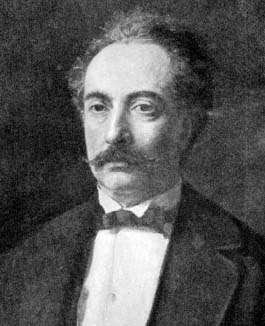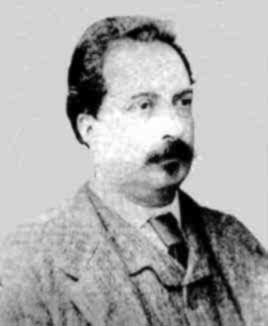<Back to Index>
- Mathematician Eugenio Beltrami, 1835
- Composer Rodolphe Kreutzer, 1766
- Pakistani Nationalist Choudhary Rahmat Ali, 1897
PAGE SPONSOR



Eugenio Beltrami (November 16, 1835, Cremona – February 18, 1900, Rome) was an Italian mathematician notable for his work concerning differential geometry and mathematical physics. His work was noted especially for clarity of exposition. He was the first to prove consistency of non - Euclidean geometry by modeling it on a surface of constant curvature, the pseudosphere, and in the interior of an n-dimensional unit sphere, the so-called Beltrami – Klein model. He also developed singular value decomposition for matrices, which has been subsequently rediscovered several times. Beltrami's use of differential calculus for problems of mathematical physics indirectly influenced development of tensor calculus by Gregorio Ricci - Curbastro and Tullio Levi - Civita.
Beltrami was born in Cremona in Lombardy, then a part of the Austrian Empire, and now part of Italy. He began studying mathematics at University of Pavia during 1853, but was expelled from Ghislieri College during 1856 due to his political opinions. During this time he was taught and influenced by Francesco Brioschi. He had to discontinue his studies because of financial hardship and spent the next several years as a secretary working for the Lombardy – Venice railroad company. He was appointed to the University of Bologna as a professor during 1862, the year he published his first research paper. Throughout his life, Beltrami had various professorial jobs at universities in Pisa, Rome and Pavia. From 1891 until the end of his life Beltrami lived in Rome. He became the president of the Accademia dei Lincei during 1898 and a senator of the Kingdom of Italy during 1899.
During 1868 Beltrami published two memoirs (written in Italian; French translations by J. Hoüel appeared during 1869) dealing with consistency and interpretations of non - Euclidean geometry of Bolyai and Lobachevsky. In his "Essay on an interpretation of non - Euclidean geometry", Beltrami proposed that this geometry could be realized on a surface of constant negative curvature, a pseudosphere. For Beltrami's concept, lines of the geometry are represented by geodesics on the pseudosphere and theorems of non - Euclidean geometry can be proved within ordinary three - dimensional Euclidean space, and not derived in an axiomatic fashion, as Lobachevsky and Bolyai had done previously. During 1840, Minding already considered geodesic triangles on the pseudosphere and remarked that the corresponding "trigonometric formulas" are obtained from the corresponding formulas of spherical trigonometry by replacing the usual trigonometric functions with hyperbolic functions; this was further developed by Codazzi during 1857, but apparently neither of them noticed the association with Lobachevsky's work. In this way, Beltrami attempted to demonstrate that two - dimensional non - Euclidean geometry is as valid as the Euclidean geometry of the space, and in particular, that Euclid's parallel postulate could not be derived from the other axioms of Euclidean geometry. It is often stated that this proof was incomplete due to the singularities of the pseudosphere, which means that geodesics could not be extended indefinitely. However, John Stillwell remarks that Beltrami must have been well aware of this difficulty, which is also manifested by the fact that the pseudosphere is topologically a cylinder, and not a plane, and he spent a part of his memoir designing a way around it. By a suitable choice of coordinates, Beltrami showed how the metric on the pseudosphere can be transferred to the unit disk and that the singularity of the pseudosphere corresponds to a horocycle on the non - Euclidean plane. On the other hand, in the introduction to his memoir, Beltrami states that it would be impossible to justify "the rest of Lobachevsky's theory", i.e. the non - Euclidean geometry of space, by this method.
In the second memoir published during the same year (1868), "Fundamental theory of spaces of constant curvature", Beltrami continued this logic and gave an abstract proof of equiconsistency of hyperbolic and Euclidean geometry for any dimension. He accomplished this by introducing several models of non - Euclidean geometry that are now known as the Beltrami – Klein model, the Poincaré disk model, and the Poincaré half - plane model, together with transformations that relate them. For the half - plane model, Beltrami cited a note by Liouville in the treatise of Monge on differential geometry. Beltrami also showed that n-dimensional Euclidean geometry is realized on a horosphere of the (n + 1) - dimensional hyperbolic space, so the logical relation between consistency of the Euclidean and the non - Euclidean geometries is symmetric. Beltrami acknowledged the influence of Riemann's groundbreaking Habilitation lecture "On the hypotheses on which geometry is based" (1854).
Although today Beltrami's "Essay" is recognized as very important for the development of non - Euclidean geometry, the reception at the time was less enthusiastic. Cremona objected to perceived circular reasoning, which even forced Beltrami to delay the publication of the "Essay" by one year. Subsequently, Felix Klein failed to acknowledge Beltrami's priority in construction of the projective disk model of the non - Euclidean geometry. This reaction can be attributed in part to the novelty of Beltrami's reasoning, which was similar to the ideas of Riemann concerning abstract manifolds. J. Hoüel published Beltrami's proof in his French translation of works of Lobachevsky and Bolyai.